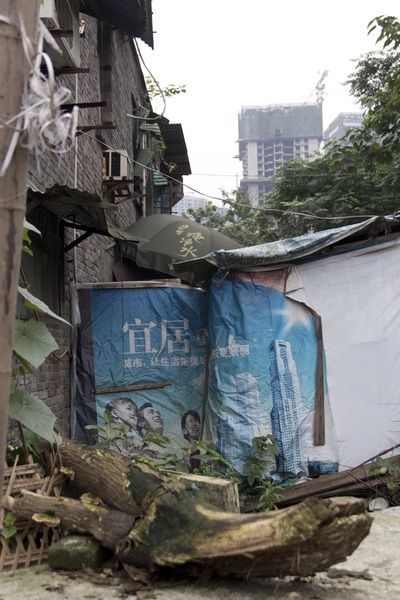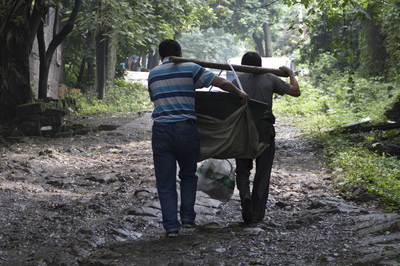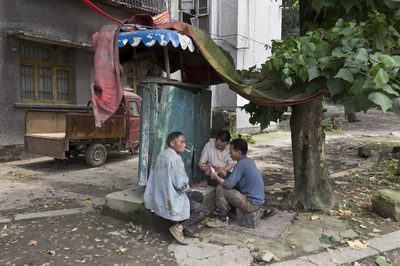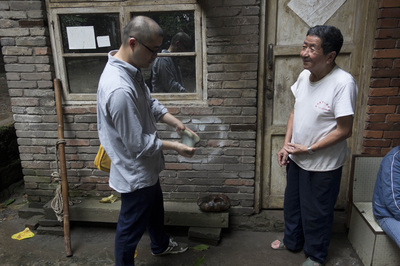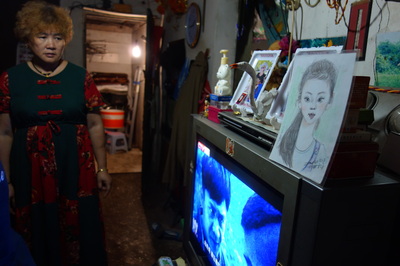
UNCONSCIOUS POWER: THE ACT OF COLLECTIVE CREATIVITY (2014)
Seila worked with local residents and artists in Tongjianju - one of the last low-rise neighbourhoods in Chonqging, a neglected space important to inhabitants’ using recycled materials left by previous dwellers. The project explored the role of creativity; inspired by the creative way locals generate artefacts enabling local artistic collaborations to result. Project developed while at residence at Organhaus (China).
"
Unconscious power. The act of collective creativity" is a project about creativity, and how locals in a particular area called Tongjianju (Chongqing, China) do generate artifacts in a creative manner and include them in their normal lives. These creations could be called “art” and the reasons for their making informs the definition of what art is. Many questions arise from this interaction, such as, what is the relationship between art and society? does art have an epistemological impact as well as an aesthetic function? what is the real value of creativity within a community? is creativity part of the natural instincts of the human being? does the context influence inhabitant’s creativity?
Unconscious power. The act of collective creativity" is a project about creativity, and how locals in a particular area called Tongjianju (Chongqing, China) do generate artifacts in a creative manner and include them in their normal lives. These creations could be called “art” and the reasons for their making informs the definition of what art is. Many questions arise from this interaction, such as, what is the relationship between art and society? does art have an epistemological impact as well as an aesthetic function? what is the real value of creativity within a community? is creativity part of the natural instincts of the human being? does the context influence inhabitant’s creativity?
Tongjianju is the context where this project took place as everything in this place is part of a complex history in China. It was created as social housing for the Copper Cash Manufactory build in 1904, which later on was converted into the Ammunition Plant (1930) employing over 110000 workers. In these days, this area of housing for the factory is suffering a demolition process that started years ago. This place then is half abandoned and the remaining locals have a precarious but still unique space to live in, as the area is one of the last “horizontal” spaces remaining in Chongqing. The public space has an important role in their inhabitant’s lives and the amount of materials that previous dwellers left behind are available for the locals to reuse and recycle in different ways.
The process of experiencing Tongjianju as a foreigner has been important for the artist, the communication with body language, the curiosity from the artist and the curiosity of the locals generated a particular relationship between them. During this time, Seila has explored the space documenting some creations (artworks) that the locals made in this place. The process includes conversations with the locals about themselves, without talking about art but talking about creativity, aesthetics, functionality and history of these art installations, many issues related with their life appeared.
The “artworks” were both in the public and private space and that was the starting point for the project in order to explore people’s perceptions. This process grew quickly from the very beginning to something unexpected, and from those conversations about creativity some locals started to amend and modify certain installations they had generated. Jian, a local in Tongjianju is the best example for this. He had decorated his house in an unique way. He explained that his reason for doing this was: “art makes my life better and meaningful”. While these conversations were happening he decided to modify some content in his house from his own criteria.
From these experiences, the artist decided to run a workshop with some Chongqing artists and locals as an experiment to generate a closer understanding about those concepts and questions about what art is and represents. For this workshop, the context (Tongyuanju) was the container and content, and the materials around were the resources to make this installation happen. Sculpting power was a 2 days workshop ran in collaboration with Wang Haichuan, Liu Weiwei, Liyong, Douyulong and Yu Guo and locals from the area. This workshop was part of the process in this project and it was a key point to develop a closer relationship with locals in Tongyuanju and local artists. The installation was presented in the T1 exhibition space, an abandoned house (16.9m2), an empty space that was filled with ideas and collaborative work.
The process of experiencing Tongjianju as a foreigner has been important for the artist, the communication with body language, the curiosity from the artist and the curiosity of the locals generated a particular relationship between them. During this time, Seila has explored the space documenting some creations (artworks) that the locals made in this place. The process includes conversations with the locals about themselves, without talking about art but talking about creativity, aesthetics, functionality and history of these art installations, many issues related with their life appeared.
The “artworks” were both in the public and private space and that was the starting point for the project in order to explore people’s perceptions. This process grew quickly from the very beginning to something unexpected, and from those conversations about creativity some locals started to amend and modify certain installations they had generated. Jian, a local in Tongjianju is the best example for this. He had decorated his house in an unique way. He explained that his reason for doing this was: “art makes my life better and meaningful”. While these conversations were happening he decided to modify some content in his house from his own criteria.
From these experiences, the artist decided to run a workshop with some Chongqing artists and locals as an experiment to generate a closer understanding about those concepts and questions about what art is and represents. For this workshop, the context (Tongyuanju) was the container and content, and the materials around were the resources to make this installation happen. Sculpting power was a 2 days workshop ran in collaboration with Wang Haichuan, Liu Weiwei, Liyong, Douyulong and Yu Guo and locals from the area. This workshop was part of the process in this project and it was a key point to develop a closer relationship with locals in Tongyuanju and local artists. The installation was presented in the T1 exhibition space, an abandoned house (16.9m2), an empty space that was filled with ideas and collaborative work.
Unconscious Power, the act of collective creativity was presented as a work in progress in a form of a participatory exhibition where the installation created at Sculpting power workshop was presented with the selection of some "artworks" that the locals had generated themselves, either in the public space and their private spaces that were opened for the public to access. The audience was able to visit them with a map the artist designed for them with images and location of the works. Those works were selected with a particular criteria based on Seila’s understanding of art in collaboration with locals who created those works or who took part in discussion about them (process documented in film).
With the map the audience was able to explore the area looking for the selected artworks and invited to suggest others they would think could be "artworks" reflecting their own perspectives. This methodology was important as continuing with the perception of what art is in an active way and enable the audience to experience the area in a different way. This event happened the 29th of June 2014.
This project by Seila Fernández Arconada is part of the long term project T1 started in 2009 by Wang Haichuan in Tongjianju (Chongqing, China). The project was done during Seila's art residency at Organhaus in June 2014 which supported the project. Seila Fernández Arconada was funded by the British Council and Arts Council of England, Transnational Dialogues and the Goethe Institute to develop this work.


